What makes Methodist, Baptist, and Presbyterian different? These Protestant denominations share a common history but have many differences. They differ in their beliefs, how they organize, and how they practice their faith. Knowing these differences helps us understand the rich tapestry of American Christianity.
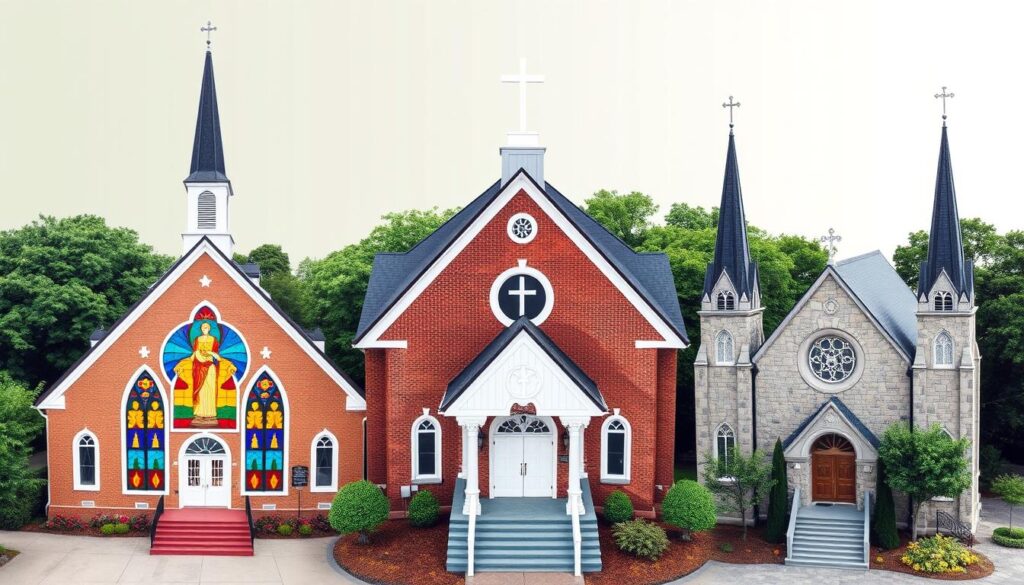
Key Takeaways
- Methodists, Baptists, and Presbyterians have different views on Scripture, God, and how to be saved.
- They also vary in church leadership, worship, and sacraments.
- Their histories and key figures shape their unique identities.
- They disagree on predestination, free will, and the role of grace in salvation.
- Methodists, Baptists, and Presbyterians have different ways of choosing church leaders.
Historical Origins of Methodist, Baptist and Presbyterian
The Methodist and Presbyterian movements both started in the Protestant Reformation. But they have their own paths and identities. The Methodist origins began in the 18th century in England. Anglican priest John Wesley wanted to make the Church of England better through personal faith and helping others.
Wesley’s ideas led to the Methodist Episcopal Church in America in 1784. This was the start of the Methodist church.
The Presbyterian origins go back to the 16th century in Scotland. John Knox was a key figure in the Presbyterian movement. His teachings about God’s power and predestination drew many followers.
This led to the Presbyterian Church in the American colonies in the 17th and 18th centuries.
The Methodist Movement
The Methodist movement started in the Anglican Church with John Wesley at its core. Wesley focused on saving souls, fighting for justice, and the power of faith. This inspired Methodism to grow in England and the American colonies.
The Methodist Episcopal Church was formed in the U.S. in 1784, after the American Revolution. It grew fast during the Second Great Awakening in the early 19th century.
The Presbyterian Movement
The Presbyterian movement began with the Protestant Reformation, especially with John Calvin and John Knox. Knox’s work in Scotland led to the Presbyterian Church. It then spread to the American colonies in the 17th and 18th centuries.
The Presbyterian Church in America faced splits over beliefs and slavery. This led to different Presbyterian groups.
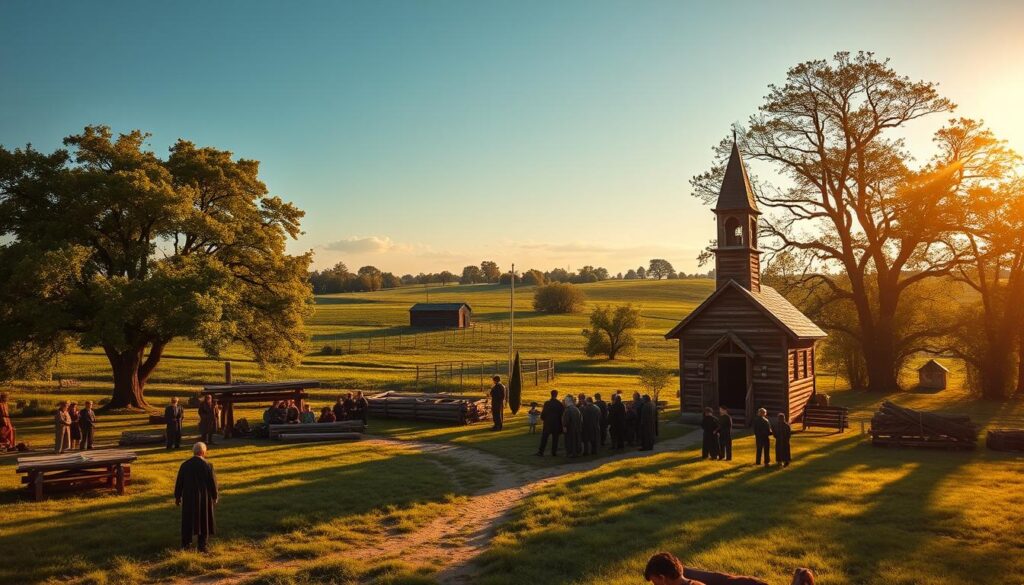
“Methodism has long been characterized by its emphasis on personal piety, social activism, and the transformative power of faith.”
Theological Beliefs
The Methodist and Presbyterian denominations have their own views on theology. Methodists believe in Arminian theology, which focuses on free will in salvation. They don’t agree with predestination from Calvinism. Presbyterians, however, believe in Calvinist theology and God’s sovereignty, including predestination.
Methodist Theology
Methodists think everyone can be saved and know they are saved. They don’t believe in predestination. Instead, they talk about prevenient grace, which helps people choose salvation. They see baptism as a sign of new life, accepting all types of baptism.
Presbyterian Theology
The Presbyterian faith is based on the Westminster Confession (1645–1647). They follow Calvinism and believe in predestination. They think God controls salvation, and sin keeps humans from God. They have two sacraments: baptism and communion, often using sprinkling or pouring.
Both denominations believe in the Bible’s authority and Jesus’ divinity. They also agree on the need for grace for salvation. But, their different views shape their unique identities and practices.
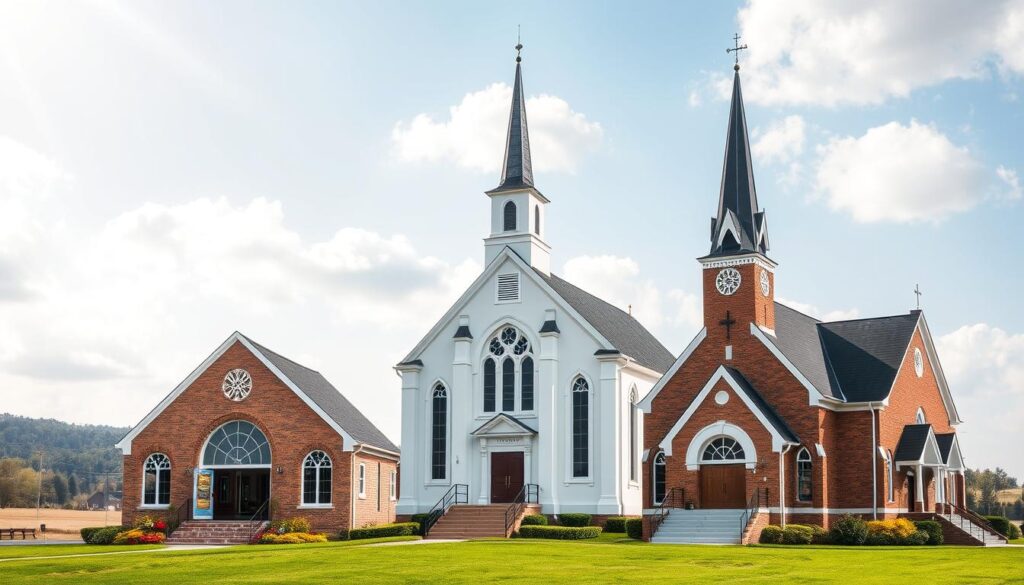
Church Governance of Methodist, Baptist and Presbyterian
The Methodist Church and the Presbyterian Church have different ways of governing. This shows their unique beliefs. The Methodist Church has a top-down structure. Bishops manage regional groups and pick pastors for local churches.
On the other hand, the Presbyterian Church relies on elders (presbyters) to lead. These elders run the local church and join forces in bigger groups.
The reason for these differences lies in their beliefs. The Methodists value a strong leader to keep things consistent. The Presbyterians, however, believe in local church freedom and group decision-making.
| Methodist Church Governance | Presbyterian Church Governance |
|---|---|
| Hierarchical structure with bishops overseeing regional conferences | Governed by a system of elders (presbyters) in local, regional, and national governing bodies |
| Bishops appoint pastors to local congregations | Elders lead the local church and work together in governing bodies |
| Emphasizes centralized authority for consistency in doctrine and practice | Emphasizes the autonomy of local churches and collective decision-making |
This difference in governance shows the deeper theological gaps between the Methodist and Presbyterian churches. These gaps have shaped their views on church leadership and structure.
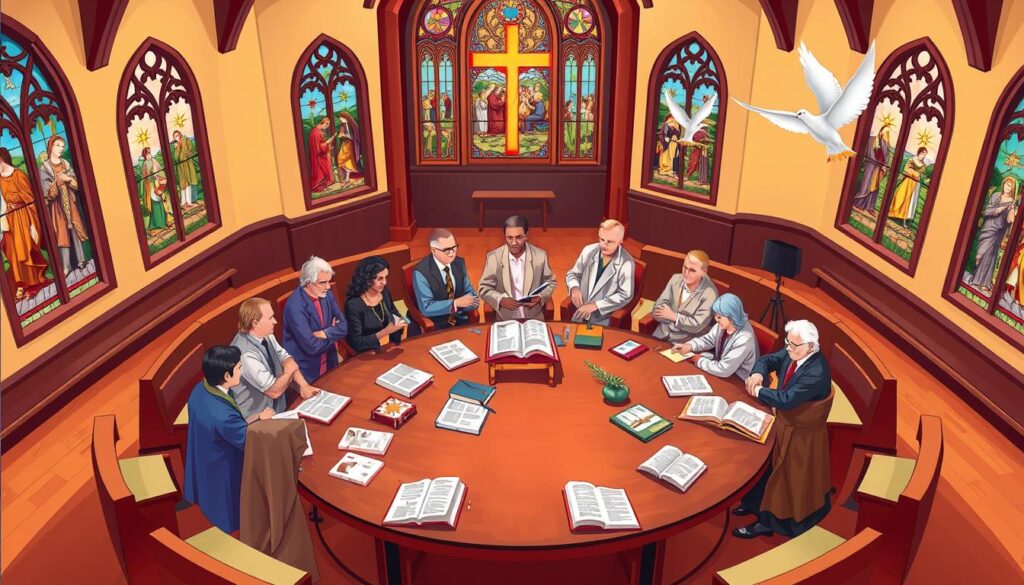
Worship Practices of Methodist, Baptist and Presbyterian
Methodist Worship
Methodist worship mixes old traditions with personal faith experiences. They recognize two sacraments: baptism and communion. These are seen as signs of God’s grace, not ways to get grace. The Methodist Church also values preaching and studying the Bible a lot.
Methodist services often have hymns, prayers, and a sermon by a minister. The service follows a set order, with parts like the Call to Worship and Benediction. But, different Methodist churches might do things differently, mixing old and new ways.
The Methodist Church believes everyone can participate in worship. Lay people help out by ushering, reading, or even preaching sometimes. This shows Methodist belief in the “priesthood of all believers,” where all Christians can connect directly with God and serve in ministry.
| Key Aspects of Methodist Worship | Description |
|---|---|
| Sacraments | Methodists observe two sacraments: baptism and communion, which are seen as symbols of God’s grace. |
| Preaching | The Methodist Church places a strong emphasis on preaching and the study of Scripture. |
| Liturgy | Methodist worship services follow a structured liturgical format, but can vary in their specific practices. |
| Lay Participation | Methodists value the involvement of the entire congregation in the worship experience. |
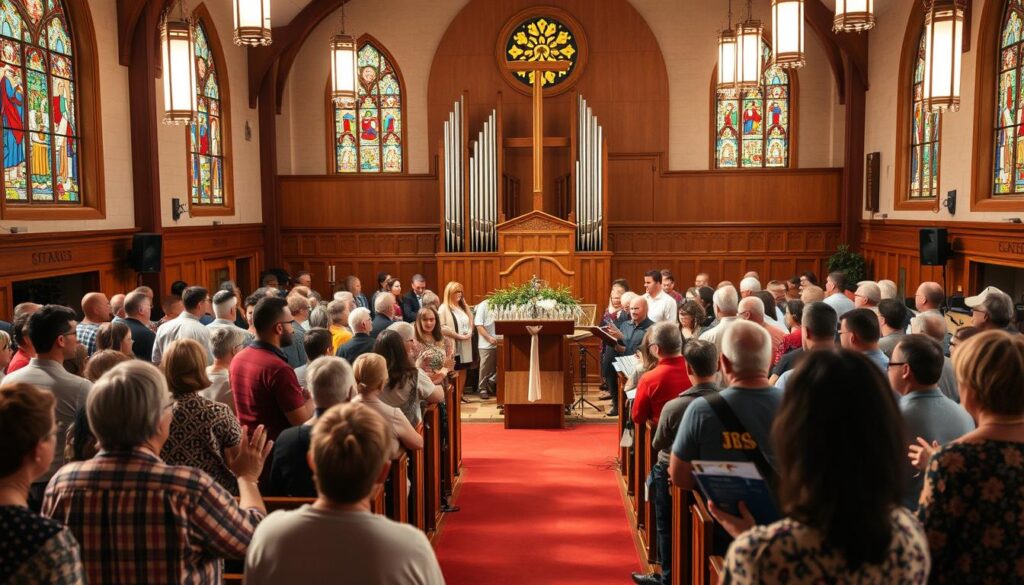
In summary, Methodist worship blends old traditions with personal faith. It focuses on preaching, sacraments, and everyone’s active role in worship.
Sacraments
The Methodist and Presbyterian denominations both value baptism and communion. Yet, they see these rituals differently. These views show the unique paths these Christian groups have taken.
Methodist Sacraments
For Methodists, baptism and communion are “means of grace.” They believe these rituals show God’s grace in a real way. They accept different baptisms, including for babies, as signs of new life.
The Lord’s Supper is seen as a way to remember Christ’s sacrifice. It’s a chance for believers to feel God’s grace.
Presbyterian Sacraments
Presbyterians, from the Reformed tradition, also see baptism and communion as important. They believe baptism is a sign of God’s promise and a way to join Christ’s body. The Lord’s Supper is seen as a way for God to work in believers’ lives.
| Sacrament | Methodist Perspective | Presbyterian Perspective |
|---|---|---|
| Baptism | Symbol of new life and regeneration; valid in various forms, including infant baptism | Sign of God’s covenant and a means of grace; incorporation into the body of Christ |
| Communion | Remembrance of Christ’s atonement; a means of receiving God’s grace | Sacrament that allows God to work in a significant spiritual way, nourishing the faithful |
These views on sacraments highlight the differences between Methodists and Presbyterians. They show how each group sees grace, salvation, and the divine-human relationship.
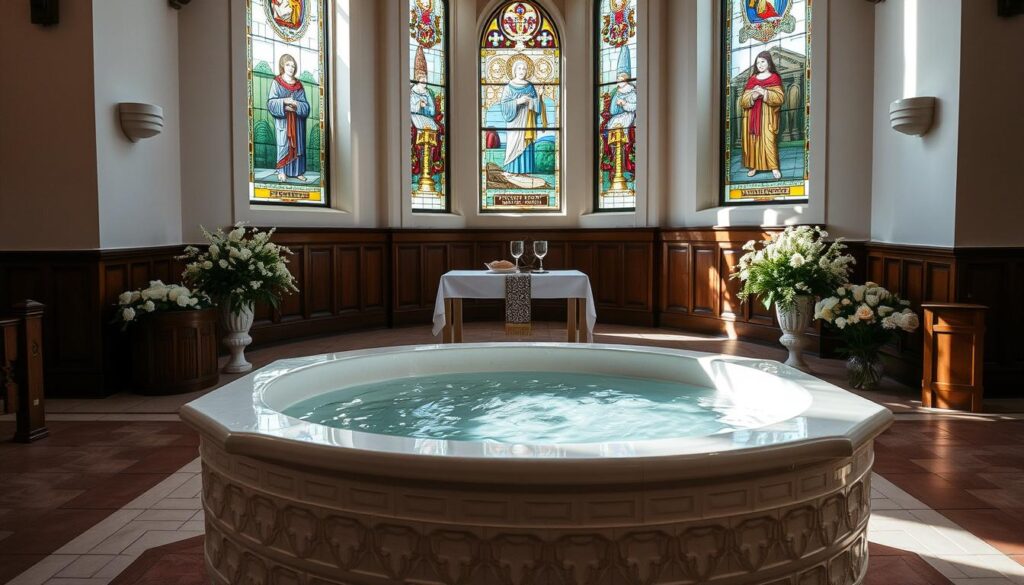
Salvation and Grace
The ideas of salvation and grace are key to understanding the differences between Methodists and Presbyterians. Methodists believe in “prevenient grace,” which means God’s grace is open to everyone. People can then choose to accept or reject this grace. On the other hand, Presbyterians follow the Calvinist view of predestination. They believe God has already decided who will be saved.
This difference is a big part of what sets these two denominations apart. Methodists stress the role of free will in salvation. Presbyterians, however, see God’s choice as the main factor in who is saved.
| Methodist Salvation | Presbyterian Salvation |
|---|---|
| Prevenient grace – God’s grace is available to all | Predestination – God has predetermined who will be saved |
| Individuals can freely choose to accept or reject salvation | God’s sovereign election is the primary factor in salvation |
The difference in methodist salvation and presbyterian salvation affects how each views grace and free will. Methodists think people can choose to accept God’s grace. Presbyterians believe salvation depends solely on God’s will.
“For by grace you have been saved through faith. And this is not your own doing; it is the gift of God, not a result of works, so that no one may boast.” – Ephesians 2:8-9
Even with these differences, both Methodists and Presbyterians agree on the power of God’s grace. They also believe faith in Christ is essential for salvation.
Key Differences between Methodist vs Baptist vs Presbyterian
Methodists, Baptists, and Presbyterians share a common Protestant heritage. Yet, they have distinct theological beliefs, church governance, and worship practices. These denominations have shaped American religious history with their unique perspectives and traditions.
Theological Beliefs
Methodists and Presbyterians differ in their views on salvation. Methodists believe in free will, while Presbyterians lean towards predestination. Baptists, meanwhile, emphasize God’s sovereignty and eternal security.
Church Governance
Methodists and Presbyterians have a hierarchical structure. Methodists are organized under bishops and annual conferences. Presbyterians are governed by elders. Baptists, however, follow a congregational model, where each church is self-governing.
Worship Practices
Worship practices vary among these denominations. Methodists and Presbyterians have formal liturgies. Baptists prefer a more informal and spontaneous approach. Baptists also value personal testimonies and spiritual experiences in worship.
Sacraments
Methodists and Presbyterians recognize two sacraments: baptism and communion. Baptists, however, only acknowledge baptism as a necessary step in conversion.
These differences highlight the unique aspects of each denomination. They show the diversity within Protestantism. Understanding these differences offers insights into the history, theology, and culture of the United States.
| Denomination | Theological Beliefs | Church Governance | Worship Practices | Sacraments |
|---|---|---|---|---|
| Methodist | Arminian theology, emphasis on free will | Hierarchical, connectional system of bishops and annual conferences | Formal and structured liturgies | Baptism and communion |
| Baptist | Calvinist theology, emphasis on sovereignty of God | Congregational, autonomous local churches | Informal and spontaneous worship | Baptism |
| Presbyterian | Calvinist theology, emphasis on predestination | Hierarchical, presbyterian system of elders | Formal and structured liturgies | Baptism and communion |
Predestination and Free Will
The debate between Methodists and Calvinists centers on predestination. Calvinists believe God has chosen who will be saved. Methodists, however, follow Arminian theology, which puts human free will first in salvation.
Methodists think God’s grace is for everyone. They believe people can choose to accept or reject salvation. This idea is called “prevenient grace,” which helps people make their own choices.
John Wesley, the founder of Methodism, shaped this view. He opposed Calvinist unconditional election, seeing it as lessening human choice. Wesley believed in “conditional preservation of the saints,” where people work with God’s grace.
Methodists see salvation as a journey, not a fixed event. They believe you can lose your salvation if you reject God’s grace. This is different from Calvinism, which says those chosen for salvation can never lose it.
The debate between Calvinism and Arminianism is deep and complex. Some people blend elements from both, like “Four-Point Calvinists” or “Four-Point Arminians.”
Church Leadership
The Methodist and Presbyterian denominations have different ways of choosing church leaders. They both value spiritual leaders, but their methods and who has the power are quite different.
Methodist Clergy
The Methodist Church has a clear hierarchy. Bishops manage regional conferences and pick methodist clergy for local churches. These methodist clergy lead worship, preach, and care for their communities. The ordination process is led by the bishop, who chooses and commissions the methodist clergy.
Presbyterian Clergy
The Presbyterian Church, on the other hand, relies on elders (or presbyters) to lead local churches. These presbyterian clergy are chosen and ordained by the local presbytery. This group includes both elders and ministers. This way, local churches have more freedom.
| Methodist Clergy | Presbyterian Clergy |
|---|---|
| Hierarchical structure with bishops overseeing regional conferences | Governed by a system of elders (presbyters) in local churches and regional bodies |
| Clergy appointed by bishops to serve in local congregations | Clergy selected and ordained by the local presbytery |
| Centralized ordination process led by bishops | Decentralized ordination process involving the local presbytery |
The differences in leadership between Methodists and Presbyterians show their unique beliefs and ways of organizing. These differences affect how they pick, train, and empower their spiritual leaders.
READ: BSF John Lesson 2 Day 4
Baptism Practices
Methodists and Presbyterians have different views on baptism. Methodists see baptism as a symbol of new life and spiritual rebirth. They accept various forms, including infant baptism. Presbyterians, however, view baptism as a sign of God’s covenant and a way to receive grace. They often use sprinkling or pouring water during baptism.
In the Methodist tradition, infant baptism is common. It shows their belief in God’s grace before any human response. Methodists also accept adult baptism for those unbaptized. They recognize sprinkling, pouring, and immersion as valid baptism forms.
Presbyterians, on the other hand, prefer sprinkling or pouring water during baptism. They see it as a symbol of the Holy Spirit’s cleansing power. While they practice infant baptism, they see it as a sign of God’s covenant, not just a symbol of new life.
| Baptism Practice | Methodists | Presbyterians |
|---|---|---|
| Infant Baptism | Commonly Practiced | Practiced |
| Adult Baptism | Accepted | Less Common |
| Baptism Form | Sprinkling, Pouring, Immersion | Sprinkling, Pouring |
| Theological Significance | Symbol of New Life and Regeneration | Sign of God’s Covenant and Means of Grace |
The different views on methodist baptism, presbyterian baptism, infant baptism, adult baptism, and baptism forms show the unique beliefs of these two Protestant denominations.
Famous Pastors and Figures
Methodist Pastors
The Methodist Church has a rich history of influential pastors. At the forefront are John Wesley and Charles Wesley, the founders. They shaped Methodism’s theology and practice in the 18th century.
Today, Adam Hamilton, Adam Weber, and Jeff Harper stand out. They are known for their dynamic preaching and commitment to social justice. Their work has earned them respect in the Methodist community.
Presbyterian Pastors
The Presbyterian Church has a long list of notable figures. John Knox, the Scottish Reformer, is seen as the father of Presbyterianism. Other notable pastors include Charles Finney and Peter Marshall.
Recently, James Kennedy, R.C. Sproul, and Tim Keller have made a big impact. Their preaching and writing have shaped the Presbyterian tradition.
READ: BSF Lesson 20 Day 2
Similarities and Distinctions between Methodist vs Baptist vs Presbyterian
Methodists, Baptists, and Presbyterians all come from Protestant Christianity. They agree on the Bible’s authority, Jesus’ divinity, and the need for grace. Yet, they have different views on theology, church organization, and practices.
Methodists believe in free will, unlike Calvinist views held by Presbyterians. Baptists have a unique way of making decisions in their churches. Methodists have a more structured approach, with conferences making big decisions. Presbyterians have a mix, with elders and regional groups playing key roles.
When it comes to sacraments, Baptists mainly use immersion for baptism. Methodists accept different ways, like sprinkling. Methodists also celebrate more sacraments than Baptists and Presbyterians.
Despite their differences, these denominations share a common Protestant heritage. They believe in the Bible, Jesus’ divinity, and the importance of grace. Their unique views, structures, and practices make them distinct within Protestantism.
| Characteristic | Methodists | Baptists | Presbyterians |
|---|---|---|---|
| Theology | Arminian free will | Diverse, ranging from Calvinism to Arminianism | Calvinist predestination |
| Church Governance | Hierarchical structure with conferences | Congregationalist or elder-led congregationalist | Representative system through elders and regional presbyteries |
| Sacraments | Observe more sacraments, including communion and baptism | Observe fewer sacraments, mainly baptism by immersion | Observe limited sacraments, similar to Baptists |
Conclusion
The differences between Methodists, Baptists, and Presbyterians show the rich diversity of Protestant Christianity. Each has its own unique beliefs and ways of organizing. Looking at these differences helps us understand Christianity in the United States better.
Methodists focus on personal spiritual experiences and the risk of losing salvation. Presbyterians believe in predestination, saying salvation is decided by God. These beliefs shape their worship, sacraments, and leadership.
Despite their differences, Methodists, Baptists, and Presbyterians all believe in the Bible, God’s grace, and Jesus Christ. Knowing about these protestant denominations, christian faith, and theological differences helps us appreciate their church practices and traditions.
FAQs
What are the key differences between the Methodist, Baptist, and Presbyterian denominations?
Methodist, Baptist, and Presbyterian denominations come from the Protestant Reformation. Yet, they differ in beliefs, church structure, worship, and views on sacraments and salvation.
What are the origins of the Methodist and Presbyterian movements?
John Wesley founded the Methodist movement, aiming to revitalize the Church of England. The Presbyterian movement started with John Calvin and John Knox, key figures in the Protestant Reformation.
How do Methodist and Presbyterian theologies differ?
Methodists believe in free will for salvation, opposing predestination. Presbyterians, however, believe in God’s sovereignty and predestination.
How do the church governance structures of Methodists and Presbyterians differ?
Methodist churches have a hierarchical system with bishops. Presbyterian churches are led by elders, who govern at local and national levels.
What are the key differences in worship practices between Methodists and Presbyterians?
Methodist worship combines traditional and personal elements. Presbyterian worship is more formal and liturgical.
How do Methodists and Presbyterians view and practice the sacraments of baptism and communion?
Methodists see baptism as a symbol of new life. Presbyterians view it as a sign of God’s covenant. Both have unique views on the Lord’s Supper.
What are the key differences in beliefs about salvation and grace between Methodists and Presbyterians?
Methodists believe in prevenient grace, available to all. Presbyterians believe in predestination, where God chooses who will be saved.
How do the differences between Methodists, Baptists, and Presbyterians reflect the diversity of the Protestant Christian tradition?
Methodists, Baptists, and Presbyterians share a Protestant heritage but differ in theology, structure, and practice. These differences highlight the diversity and complexity of Protestant Christianity in the United States.

